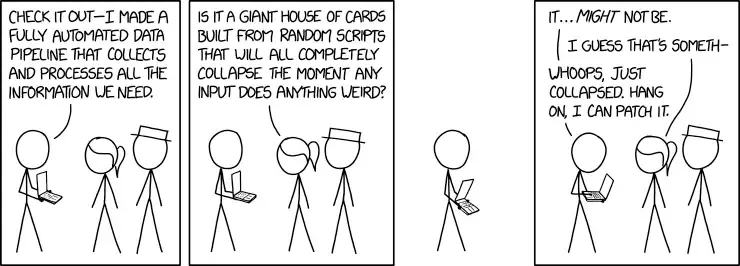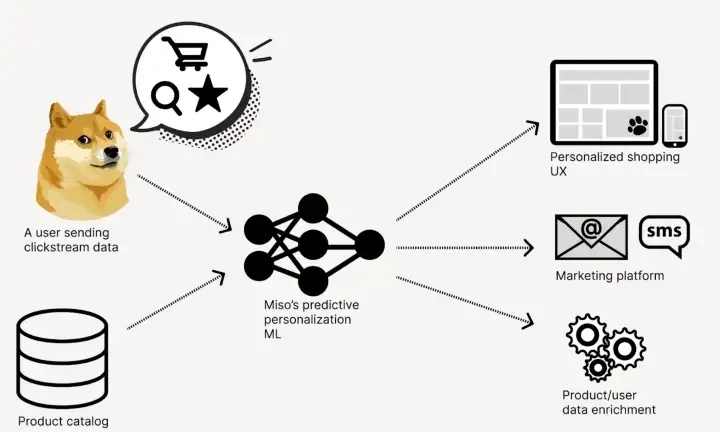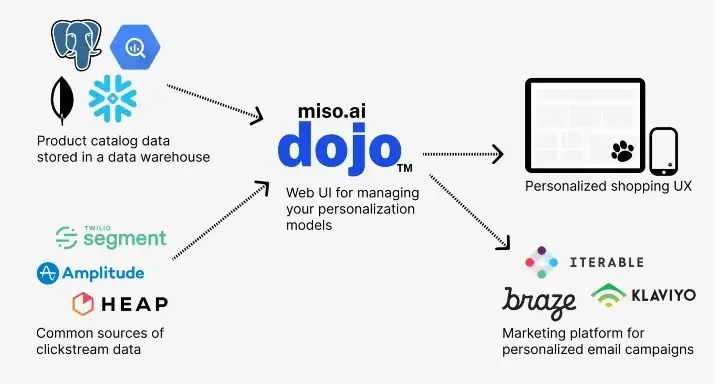Building with Miso.ai: System Architecture

At Miso.ai, our mission to democratize Personalization ML drives every aspect of our company, including our system architecture. Our design philosophy is straightforward — build tools that are as open, extensible, and decentralized as possible. Most of our customers and prospects are heavily invested in the products that comprise their tech stack, which are each uniquely complex given their enterprise needs. In this article, we’ll explore how Miso.ai is designed to provide immediate, performant value to product teams and layer into any tech stack.

Personalization using local ML
When we began the research that became Miso.ai, we had a simple realization that clickstream events could be powerful signals of user intent and preferences. In e-commerce shops, we track users browsing, clicking, adding to cart, and purchasing products. For media sites, we track events like bookmarking, reading, and watching instead. These events, which tell the story of a user’s session, are sent to Miso.ai via API, along with information about the product catalog.
Miso’s predictive data models, which perform multivariate embedding-based clustering, output a rank-sorted list of items that we predict are most relevant to a given user (even if they’re anonymous). We can make these predictions well at baseline (before the reinforcement learning kicks in) because of our unique approach to embedding, which map users and products within the same vector space. Additionally, the rank-sorting can be tailored to optimize metrics like conversion rate, average order value, and gross merchandise value. These insights can then be used to personalize various ribbons or carousels on a site, be plugged into marketing platforms, or used for data enrichment. It looks like this:

Miso.ai’s suite of personalization tools, such as the Search and Recommendation engines, are built using an API-first approach. Therefore, any platform that can connect to an API endpoint (or connect to a data pipelining tool that can connect to an API endpoint) can be seamlessly used with Miso. We also support a wide range of built-in integrations with popular SaaS platforms to make it even faster to get started.
Taking an API-first approach means that our APIs are designed for performance. Here are some stats at a glance:

Putting it all together
No matter the size or maturity of your business, Miso.ai can layer into your tech stack and start providing immediate value. Let’s take a look at some scenarios.
It’s worth noting that the following scenarios are based on generalizations of what we’ve seen from our customers, just for context. Every organization has unique requirements and the best solution may be a combination of APIs, SDKs, and integrations.
Scenario 1 — E-commerce platform integration
Suppose you’re an e-commerce retailer that uses a single SaaS platform such as Shopify to handle your content management, analytics, and marketing (in addition to selling, shipping, payment processing, and everything else needed to run a successful online business).
You’ve noticed that the search functionality on your site isn’t connecting users to the right products and you’d also like to recommend products that pair well with the items already in the customer’s cart.
Companies in this stage may only have a single front-end developer (or the work has been contracted), are unlikely to have a data science team that can build an effective search and recommendation engine. Using Miso, you have an intuitive, low-code option to add this functionality to your shopping experience and immediately start seeing results.

Using a one-click integration inside Dojo (our no-code UI for managing your data sets and engines), you can import your product catalog and clickstream data from your e-commerce platform. With the Miso.ai SDK UI Extension Kit, you can quickly implement the front-end elements necessary to create a personalized shopping experience.
Scenario 2 — Custom enterprise stack
Suppose you’re the head of growth of an enterprise who has been tasked with improving the click-through rate on promotional emails. Through customer feedback, you’ve learned that customers like hearing about promotions but the featured products aren’t relevant to their browsing or behavioral history.
Companies in this stage usually have dedicated front and back-end developers and often a data scientist on the team. They tend to have invested in a tech stack with specialized platforms for customer data, content management, and marketing. With Miso, you can combine your recommendation engine with popular platform integrations to add a custom recommendation feed to your promotional emails.

In the above example, this organization is using a behavioral analytics tool for their clickstream data and storing their product catalog data in a data warehouse. That data is processed using Miso’s personalization ML models and output to the front-end client of their desktop/mobile sites and mobile app. By making an HTTP request to Miso within their marketing platform, Miso’s recommendation API can populate email templates with products that a particular customer is likely to engage with.
Final Thoughts
Integrating new software into your data pipeline can be a daunting task. This is why we’ve been so deliberate in designing Miso.ai to be as flexible as possible when implemented inside an existing tech stack. Whether you’re a brand new startup, household name in retail, or somewhere in-between, Miso.ai has a diverse set of integrations and implementation paths ready to be explored.
Want to learn more about how Miso.ai can fit into your tech stack? Check out our Quickstart tool or drop us a line at hello@miso.ai. We’d love to hear about what you’re building!